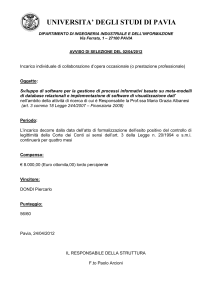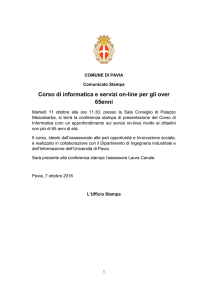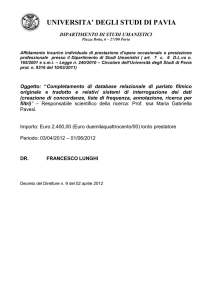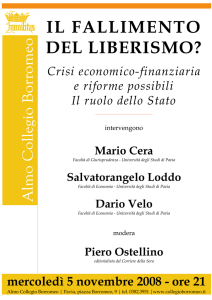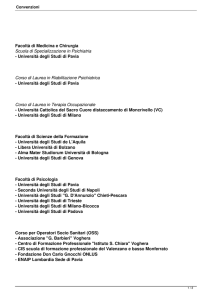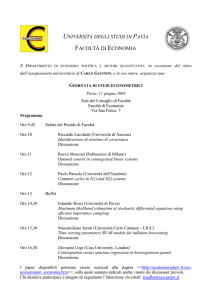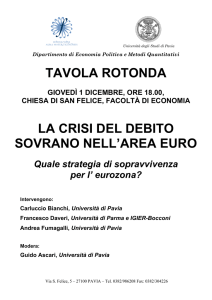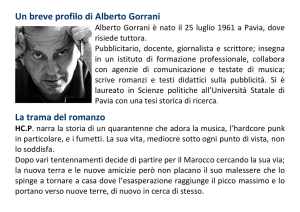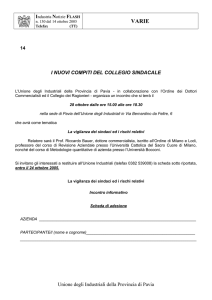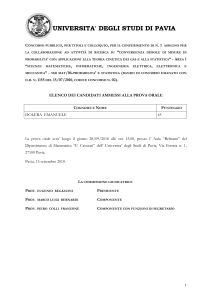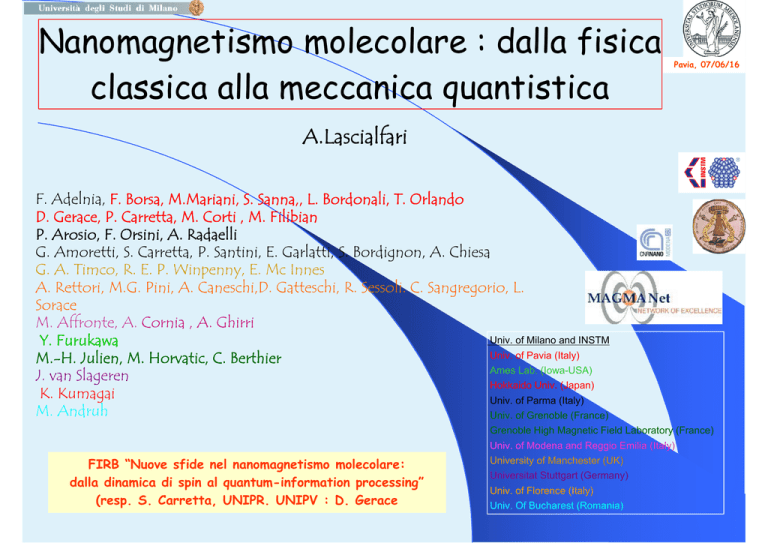
Nanomagnetismo molecolare : dalla fisica
classica alla meccanica quantistica
Pavia, 07/06/16
A.Lascialfari
F. Adelnia, F. Borsa, M.Mariani, S. Sanna,, L. Bordonali, T. Orlando
D. Gerace, P. Carretta, M. Corti , M. Filibian
P. Arosio, F. Orsini, A. Radaelli
G. Amoretti, S. Carretta, P. Santini, E. Garlatti, S. Bordignon, A. Chiesa
G. A. Timco, R. E. P. Winpenny, E. Mc Innes
A. Rettori, M.G. Pini, A. Caneschi,D. Gatteschi, R. Sessoli. C. Sangregorio, L.
Sorace
M. Affronte, A. Cornia , A. Ghirri
Univ. of Milano and INSTM
Y. Furukawa
Univ. of Pavia (Italy)
M.-H. Julien, M. Horvatic, C. Berthier
Ames Lab. (Iowa-USA)
J. van Slageren
Hokkaido Univ. (Japan)
K. Kumagai
Univ. of Parma (Italy)
M. Andruh
Univ. of Grenoble (France)
Grenoble High Magnetic Field Laboratory (France)
Univ. of Modena and Reggio Emilia (Italy)
FIRB “Nuove sfide nel nanomagnetismo molecolare:
dalla dinamica di spin al quantum-information processing”
(resp. S. Carretta, UNIPR. UNIPV : D. Gerace
University of Manchester (UK)
Universitat Stuttgart (Germany)
Univ. of Florence (Italy)
Univ. Of Bucharest (Romania)
Outline
•
Pavia, 07/06/16
Few words on magnetic field and magnetic systems
• Nanosystems. The case of molecular nanomagnets
• “Classical” effects
• Quantum effects and applications
Pavia, 07/06/16
Magnetism &
magnetic field
Magnetism and magnetic field
Pavia, 07/06/16
Natural examples : rock magnetism and earth’s field
Earth's magnetic field changes over time because
it is generated by a geodynamo (in Earth's case,
the motion of molten iron alloys in its outer core).
Bearth = 0.25 – 0.65 Gauss
The North and South magnetic
poles wander widely over geological
time scales, but sufficiently slowly
for ordinary compasses to remain
useful for navigation. However, at
irregular intervals averaging several
hundred thousand years, the
Earth's field reverses and the
North and South Magnetic
Poles relatively abruptly switch
places. These reversals of
the geomagnetic poles leave a
record in rocks that are of value
to paleomagnetists in calculating
geomagnetic fields in the past.
Such information in turn is helpful
in studying the motions of
continents and ocean floors in the
process of plate tectonics.
Il campo magnetico
Pavia, 07/06/16
Esiste sempre UNA “sorgente” di campo magnetico. Tipico esempio : la calamita
Sorgenti di campo magnetico di interesse : elettromagneti , magneti superconduttori, magneti in genere
E’ all’origine della forza magnetica (e/o viceversa) fra due o più oggetti
Ad oggi esistono molti esempi quotidiani di utilizzo del campo magnetico
Levitazione diamagnetica della rana in
alti campi magnetici (10 Tesla ; il
campo terrestre è 0.00005 Tesla)
Il “più grande”
magnete del mondo
(CERN)
Levitazione dovuta a
superconduttori
ad alta temperatura critica
Treno a
levitazione
magnetica
Il campo magnetico dovuto a
cariche elettriche circolanti
Filo elettrico percorso
da corrente : legge di
Biot-Savart
Fra due fili percorsi
da corrente :
forza magnetica
Pavia, 07/06/16
La limatura di ferro fornisce
la direzione del campo magnetico
generato dalla corrente
che percorre il filo
(vista dall’alto)
Il campo magnetico dovuto a cariche
elettriche che ruotano su se stesse
Origine del campo magnetico :
Pavia, 07/06/16
particelle aventi carica elettrica in moto
Altro tipo di moto di carica che genera un campo magnetico :
rotazione di una carica elettrica intorno a un asse
Rotazione (spinning) dell’elettrone
su se stesso : piccola calamita !!
Rotazione dell’elettrone
e del nucleo su se stessi
Magnetism in materials has atomic origin !!
Pavia, 07/06/16
M = (1/V)i mi = (1/V) i orb + spin
Magnetization
In MM, often orb 0
magnetism given by spin
“Std” magnetic systems : hysteresis and domain walls
Bulk ferromagnet
Pavia, 07/06/16
….. toward….
“Nano” – physics
i.e.
reducing the size of
the systems to nm scale
Pavia, 07/06/16
Few examples of
“nano” Magnetism applications
Pavia, 07/06/16
Biomedicine
Information Technology
Data storage
Quantum computing
Magnetic Resonance Imaging
(diagnosis)
Energy
Transportation
Energy storage
Magnetic Fluid Hyperthermia
(tumour therapy)
Magnetic (drug) delivery
Pavia, 07/06/16
Pavia, 07/06/16
Basic dates in history of Molecular
magnets or
“single-molecule magnets”
1993 early magnetic studies on Mn12
1996 QTM in Mn12
1997 QTM in Fe8
2000 Mn12 on surface
2002 Agilent Technology Award to Sessoli, Gatteschi,
Barbara, Wernsdorfer, Friedman
2004 TbPc2 (phtalocyanines)
2007 Mn6
2009 Fe4 on surface
2015 Zavoisky award to Prof. D. Gatteschi
Pavia, 07/06/16
Related research activities
QTM & other
quantum
effects
mechanisms
for M
retention
magnetothermal
effects
Mol.
Magn.
Increase
anisotropy
barrier
Pavia, 07/06/16
SMM on
surfaces
SMM for
spintronics
Some applications
Memory storage
Magneto-thermal effects
molecules on surfaces (read and write)
Information Storage & Processing:
molecular spintronics
quantum computation
hybrid cavities
Pavia, 07/06/16
Typical Magnetic Molecule
Pavia, 07/06/16
ligand
1 nm
A “total”
molecular spin
magnetic core
Molecular engineering to design nanomagnets
Pavia, 07/06/16
Cr8
A single crystal is a collection of identical nanomagnets
well separated one another and perfectly oriented
Another example of nanomagnet:
crystal of Fe8
Few magnetic ions per molecule
Pavia, 07/06/16
Unit repeated over
all the crystal
Negligible magnetic
interactions
among molecules
i.e.
Molecular nanomagnets
or single molecule magnets
Studying the bulk
Investigating the single molecule
Molecular Nanomagnets (MNM)
Pavia, 07/06/16
Wide variety :
rings
( Fe10, Fe6, Cu8, Cu6, Cr8…..)
“clusters” , Single Molecule Magnets ( Mn12, Fe8, Ni10, Cr4 ,Fe4…)
chains , Single Chain Magnets
• Crystals made up of
(CoPhOMe, Dy-Ph, Gd-R, ….)
very weakly interacting molecules
magnetic properties determined by single molecule
• Clusters and rings can be
designed at will :
- number of interacting magnetic ions ( spins) geometric spatial arrangement of the ions
- single ion spin dimension ( s=1/2……s=5/2)
- exchange interaction J ( AF, FM )
Pavia, 07/06/16
Example:
High-spin
Molecular magnets
Some high spin nanomagnets
Pavia, 07/06/16
Lis, 1980
Winpenny, 1999
Mn12 S = 10
Ni12 S = 12
Fe8 S = 10
Fe19 S=33/2
Wieghardt, 1984
Powell, 2000
Pavia, 07/06/16
Example :
Low-spin
Molecular magnets
Some AF ring-like ST=0 nanomagnets
Cr(III) s = 3/2
AF ground state
(total spin ST = 0)
J 17.2 K
01 9.4 K
Fe(III) s = 5/2
AF ground state
(total spin ST = 0 )
J 13.8 K
01 5.5 K
Pavia, 07/06/16
Cr8
ST=1
9.4 K
ST=0
Fe10
ST=1
5.5 K
ST=0
Other nanomagnets…..
Fe30
Mn 3x3 grid
Phtalocyanines-based
(double deckers)
Dy6
Pavia, 07/06/16
“toroidal” moment
Single-chain magnets
(1D magnetic nanowires)
Pavia, 07/06/16
Example :
Molecular chains
Examples of molecular chains
Pavia, 07/06/16
single chain magnets
Gd-R chain. Villain’s conjecture
Pavia, 07/06/16
Why Physics of
Molecular magnets
is so interesting ?
Molecular Nanomagnets (MNM)
Pavia, 07/06/16
Classical Physics involved
• Physics of low-dimensional systems (how magnetism depends on crystal and
spin dimensionality
• Spin dynamics : how spins move when T and H are varied
• system’s dynamics, e.g. Brownian motion (due to temperature effect)
Quantum Physics involved
Due to finite number of magnetic ions discrete energy levels
- gapped ground state : level crossing effects
- “macroscopic” quantum tunneling and/or tunneling of the Neel vector
(after D.Loss et al.)
- spin dynamics in zero dimension
- measurement of the decoherence time (quantum computation)
- quantum entanglement
Pavia, 07/06/16
The switch from classical (physics)
to quantum mechanical depends
often on temperature region
of operation
Pavia, 07/06/16
“Classical” (not trivial !!) physics :
Nanoparticles
Molecular nanomagnets at “high” temperature
Nanomagnetism for “classical” NPs
Below a critical temperature, TC, some materials exhibit spontaneous magnetization
(ferro- and ferrimagnetism). Demagnetizing field induces domain formation (i.e.
uniformly magnetizated regions of different shape and size are formed).
Pavia, 07/06/16
E = Eex + Ek + Eλ + ED
Eex exchange energy, Ek magnetocrystalline
anisotropy energy, Eλ magnetoelastic energy,
ED magneto-static energy
remnant
M
coercivity
Bloch wall
The width of the domain wall
depends on the anisotropy
and exchange coupling and
=A/K
Typical values of domain
wall width are in the 10100 nm range.
A = exchange energy density
(J/m2)
K = magnetic anisotropy energy
density (J/m2)
Single Domain Nanoparticles
Pavia, 07/06/16
Total wall energy per area unit:
E=2(AK)1/2
Reducing the dimensions of the crystal: competition among E and the magnetostatic
energy, Eλ . But Eλ scales with the volume, E with the surfaces
There exists a lower limit in size, D, corresponding to the single domain
state.
Typical D values:
D=18 E / 0MS2
=
100 nm
When D< all the spins are coupled (Exchange
Energy is constant). The inversion of M occurs
through a coherent movement of all the spins of
the particle.
Fe
15 nm
Co
70 nm
Ni
55 nm
NdFeB 100 nm
Fe3O4 128 nm
-Fe2O3 166 nm
Single Domain Nanoparticles
(small ferromagnets under critical diameter dc)
Pavia, 07/06/16
Superparamagnetism (giant spin)
Stoner-Wolhfarth model:
=
Energy
dc= 20-100 nm
E
The inversion of M occurs through a
coherent movement of all the spins of
the particle
Energy barrier E=kAV
z = easy-axis of M, =angle (z,M)
kA= anisotropy constant, V= particle volume
= 0 exp(E/kBT)
Neel correlation time
If NPs interact : Vogel-Fulcher model, = 0 exp[E/kB(T-T0)]
Also in MM for studying the
fundamental physical processes and
for the applications we need to
follow the typical
times of the systems
For example some MM
are superparamagnetic
Pavia, 07/06/16
Pavia, 07/06/16
How to detect the dynamics
typical of systems ?
The (extended) “resonance”
concept
Il fenomeno della risonanza
Pavia, 07/06/16
- Consiste in una risposta “aumentata” dei
sistemi
(molla, chitarra/microfono, ponti, nuclei,
elettroni, molecole,…)
sollecitati da una azione esterna
agente a frequenze proprie dei sistemi
stessi
Quando si ha risonanza
c’è un picco nella risposta del sistema
Il fenomeno della risonanza
Pavia, 07/06/16
AMPIEZZA DELLA MOLLA
(MAX ALLUNGAMENTO)
RISONANZA DELLA MOLLA
Se la molla viene “forzata”
dall’esterno alla sua
frequenza,
aumenta l’ampiezza della sua
oscillazione
Il fenomeno della risonanza
RISONANZA SONORA : effetto Larsen in chitarre amplificate
20 Hz – 500 Hz
Time 2.00 & 3.15
Pavia, 07/06/16
Il fenomeno della risonanza
RISONANZA MECCANICA :
Ponte di Tacoma che oscilla e poi crolla causa vento a circa 67 km/h
Pavia, 07/06/16
Conditions for observing
a resonance typical of motions
inside the investigated system :
stimulate the system with
a frequency meas
near a typical system frequency c =1/c :
Pavia, 07/06/16
meas c 1
Possible motions : spin motion,
Brownian motion, molecular motion
FOR THIS PURPOSE
ONE CAN USE DIFFERENT
TECHNIQUES ABLE TO
DETECT MAGNETIC PROPERTIES
Concept of response function
(e.g. specific heat, magnetic
susceptibility)
Pavia, 07/06/16
Typical times/frequencies : how to
observe the dynamics
Pavia, 07/06/16
DC Magnetometry
AC Susceptibility
MUSR
NMR
Mössbauer
Spectroscopy
SPM particle blocking is noticeable when τm = τN at a given temperature
Pavia, 07/06/16
Some response
functions
(to the externl stimuli)
Molecular magnets
DC susceptibility : Curie law for T>100K
RINGS
Just one atom
makes the difference !!
Pavia, 07/06/16
Pavia, 07/06/16
AC susceptibility typical data : varying the frequency
Spin block : “Blocking” temperature
dispersion
absorption
Maximum (response) for
ωAC = 1
= correlation time of spins
i.e. Neel time !
Mn12
Pavia, 07/06/16
Pavia, 07/06/16
Another “source” for understanding
the response function.
An historical technique for Pavia:
Nuclear Magnetic Resonance
An historical technique for Pavia:
Nuclear Magnetic Resonance
1944
Pavia, 07/06/16
Esperimenti RMN di
Luigi Giulotto (Università di Pavia)
Isidor Isaac Rabi
The Nobel Prize in Physics 1944 was awarded to
1948/50
Isidor Isaac Rabi "for his resonance method for
recording the magnetic properties of atomic
nuclei".
Il primo esperimento di Risonanza Magnetica Nucleare
nella materia condensata (nucleo dell’atomo di idrogeno)
Magnete che genera
un campo magnetico
statico
Bobine che generano
un campo magnetico
a radiofrequenza
1945/46 : Bloch - Purcell
Campione
di H2O
Pavia, 07/06/16
NMR.
A local probe
H = Hz + HD + HCS + HQ + Hhyp + HJ + Hce
HZ = Zeeman interaction , path 1 ( B0 10 9)
HD = Dipolar interactions among nuclear spins, path 2,3 ( ISr -3 10 3-5)
HCS = Chemical shielding interaction, path 6 and 3 (1 – 10 5)
HQ = Quadrupolar interaction (nuclei I>1/2) with surrounding E), path 3 (10 3 – 10 7)
Hhyp (paramagnetic shift) = hyperfine e-n dipolar (pseudocontact) and contact interactions,
path 3 (influenced by 5)
HJ = J-coupling, path 2 via path 3
50
Hce= interaction of nuclei with conduction electrons (e.g. nuclei, Knight shift), path 3
NMR
Absorption spectra (almost static response)
Nuclear time to reach equilibrium 1/T1 :
nuclear dynamical response
Also T2
Pavia, 07/06/16
EXAMPLE AT ROOM TEMPERATURE
Pavia, 07/06/16
1D spin diffusion
Molecular chians
No spin diffusion
Molecular rings
AGAIN “CLASSICAL” BEHAVIOUR
DETECTING SPIN MOTION
Vs temperature behaviour
Peaks max resp. function at
Pavia, 07/06/16
“Quasi-classical” effect :
Muon Spin Resonance, a local
technique similar to NMR
Pavia, 07/06/16
Peaks at meas 1
Mn12
max when measc 1
In this case a bit more
complicate
due to quantum structure
of energy levels
Pavia, 07/06/16
… going to quantum world
Struttura atomica e nucleare
Pavia, 07/06/16
Organi tessuti molecole
Atomi nuclei
Particelle atomiche e subatomiche
Struttura atomica e nucleare
Pavia, 07/06/16
Quantizzazione dei
Livelli energetici
Esempio : atomo di
idrogeno
ATOMI E NUCLEI
SONO SISTEMI
QUANTISTICI
Un sistema quantistico non può assumere (in modo
continuo) tutti i valori di energia
Quantum Physics of Mn12
Few N spins : (2s+1)N levels
Pavia, 07/06/16
Discrete levels. Superparamagnetic behaviour
Pavia, 07/06/16
Quantum tunneling of the magnetization (QTM)
Pavia, 07/06/16
Thermally assisted Quantum Tunneling
Pavia, 07/06/16
Applying a field : levels change (Zeeman effect)
Pavia, 07/06/16
OFF
Res
QTM
OFF
Applying a field : levels change (Zeeman effect)
Pavia, 07/06/16
ON
Res
QTM
ON
EXPERIMENTAL EVIDENCES of QTM
Pavia, 07/06/16
vertical steps for Hz values
corresponding to the LA
the relaxation time
becomes T-independent
appearence of
step-like hysteresis
loop of M
drop of the relaxation time in proximity
of LA
Pavia, 07/06/16
Quantum energy level crossing
The ST=0 homometallic ring-like systems
Fe(III) s = 5/2
AF ground state
(total spin ST = 0)
Fe10
5.5 K
ST=0
J 13.8 K
01 5.5 K
Fe(III) s = 5/2
AF ground state
(total spin ST = 0)
J 21 K
01 15.6 K
Cr(III) s = 3/2
AF ground state
(total spin ST = 0)
J 17.2 K
01 9.4 K
ST=1
Fe6:Li
15.6 K
ST=1
ST=0
Cr8
9.4 K
ST=1
ST=0
Pavia, 07/06/16
Hamiltonian – energy levels
Hamiltonian for ring nanomagnets :
i J sisi+1 + i U(si) + ij Ui,j(si,sj) + g B Bi si
U(si) = crystal field anisotropies
Ui,j(si,sj) = intramol.dipolar interactions, hyperfine
couplings, D-M interact., higher order exch., etc.
Approximate energy levels (Landè rule) :
E(STOT) = P/2 STOT (STOT + 1)
P=4J/N
N = number of magnetic ions in the ring
• Level crossing fields depend on
the angle between field and molecular axis z
• POSSIBLE LEVEL REPULSION AT
CROSSING FIELDS (LEVEL ANTICROSSING)
Pavia, 07/06/16
Diagram of energy levels (scheme)
ANTICROSSING OR AVOIDED LEVEL CROSSING (ALC)
Pavia, 07/06/16
ALC means mixing of wave-functions
of two different levels
example case of energy levels
of Fe6:Li
IN SOME RINGS THERE IS EXPERIMENTAL EVIDENCE FOR LEVEL REPULSION AT CROSSING
FIELDS (ALC).
Questions (experimental) on fundamental structure of levels arise :
1) How can we distinguish LC from ALC ?
2) What is the “value” of ALC, i.e. the “gap” at the crossing ?
3) How (if) levels’ lifetime affects the degree of ALC ?
4) Does any other quantum effect (e.g. QT of the Neel vector, QTNV in brief)
occurs, especially near ALC or LC ?
Macroscopic probes (magnetization , EPR, specific heat,….) help , but give not
definitive answers
Evidences for ground state spin change & LC/LAC :
torque and specific heat on single x-tals
Pavia, 07/06/16
1) Peaks of dM/dH at crossing fields ; 2) Plateaus in M(H) corresponding to S=0, 1, 2,… states
Ferric wheel
Fe10
Cr8(Piv)16
Fe6:Li
=(H,c)=25°
[Cr8F8Piv16]
single crystal
0.0
S=0
-4
-2.0x10
Torque
[ (H, unique axis) = 49.8° ]
-4
T=4K
T = 0.4 K
= 45° (angle between
unique axis and B)
-4.0x10
-4
-6.0x10
0
SPECIFIC HEAT
2
4
S=1
6
Magnetic Field (T)
8
10
• Angular dependence of the crossing field
7.8
Cr8 single crystal
T = 0.4 K
7.6
Bc (T)
7.4
7.2
7.0
6.8
6.6
-20
Level anti-crossing (LAC)
0
20
40
exp (°)
60
80
100
• From specific heat : very small LAC
1H NMR on Cr8 . T1K
Pavia, 07/06/16
T = 0.3 K
10
1
-1
(sec )
1
0.1
6.5
7.0
7.5
8.0
8.5
2
3
4
0.01
0.1
T1
T1
-1
-1
-1
(sec )
1
0.01
0.1
0.0
0.2
0.4
0.6
0.8
1.0
T (K)
T
2
e
1
2
T11 A2
B
2
2
2
2 ( L ) 2
1 e T 1 N
Quasi-elastic
Cr8
0
1
5
6
7
8
9 10
H (T)
g B (H c1 H)2 21
Inelastic
Cross. Field
Hc1
Fit parameters :
1 = 0.10 (5) K , A2 = 9 (1)· 1013 rad2 Hz2 , B2 = 7 (1)·1013 rad2 Hz2 ,
1 = 4.0(3)*104 H T rad Hz, 2=4.0(6)*106 T rad Hz
The H and T dependences are due to direct, Raman or Orbach processes ? Between nuclei
and phonons or electrons and phonons ? Does QTNV play any role ?
Pavia, 07/06/16
Looking for high anisotropy barrier
For having e.g. room temperature
Storage memories
High anisotropy Single ion Magnets:
Tb-double deckers of phtalocyanines
Pavia, 07/06/16
AC susceptibility
Tb3+
(J=6)=
Ueff/kB=80K
hysteresis
Pavia, 07/06/16
Other quantum effects
Quantum phase interference
(Berry phase)
Pavia, 07/06/16
Glauber dynamics of spin chain
Pavia, 07/06/16
AC susceptibility
NMR
Single chain magnets
Phonon trapping in Ni10
Pavia, 07/06/16
[Ni10(O)(dbm)4(thme)4(BzO)2(ttOH)6]
Phys. Rev. Lett. 97, 207201 (2006).
Nonequilibrium Dynamics in Ni10 powders
From SQUID : slowing down of M,
i.e. non equilibrium situation
Ni10
For comparison : Fe8
Pavia, 07/06/16
From NMR : narrow line
(FWHM 100 KHz) i.e.
no local field due to “giant” S
Solution : resonant phonon trapping
Pavia, 07/06/16
Phonons are no more a heat bath but the joint dynamics of spin+phonons dominates
(phonons populations nph are not fixed solely by thermostat temperature)
Points : NMR
Lines : SQUID
Magnetocaloric effect:
entropy of a magnetic system
The MagnetoCaloric Effect (MCE) is the adiabatic
temperature change of a material upon application
of a magnetic field
Pavia, 07/06/16
Entropy and MCE
for Magnetic nanoparticles
classical case
McMichael et al.
Pavia, 07/06/16
quantum case:
Determination of MCE from experiments
Pavia, 07/06/16
from specific heat data:
from magnetization data:
MCE - a comparison
T(K)
ΔH (T)
inter-metallic
˜3
<10K
3T→0
Mn12
˜3
˜3K
7T→0
Mn10
12
2K
3T→0
Fe14
4
6K
7T→0
PBA
1
200K
3T→0
Mn32
15
18
3T→0
Gd2
40
2K
7T→0
Pavia, 07/06/16
Recent theoretical study(2013) on MCE
Pavia, 07/06/16
By explicitly considering Carnot refrigeration cycles, we theoretically show
that the best molecules for magnetic refrigeration between T =10K and the
sub-Kelvin region are those made of strongly ferromagnetically coupled
magnetic ions, contrarily to the established belief. (E. Garlatti et al,
APPLIED PHYSICS LETTERS 103, 202410 (2013)
Magnetic Molecules on surfaces
Single molecule read and write
review by N. Domingo et al., Chem. Soc. Rev. 2011
A. Cornia, D. Tahlam, M. Affronte (2016)
Pavia, 07/06/16
Sunset of Mn12 & sunrise of Fe4
Pavia, 07/06/16
Nature Materials 8, 194 - 197 (2009)
doi:10.1038/nmat2374
Methods of deposition
air
high vacuum
ultra-high vacuum
liquid phase
electro-spray
sublimation
molecules and nanoparticles:
- functionalized surfaces and buffer
layers
- pre-patterned surfaces
- dip-pen
- graphene
self assembly
Pavia, 07/06/16
Integrity checks (also magnetic properties)
Pavia, 07/06/16
surface
STM: lateral size as expected
Derivative
Cr7Ni-bu
Cr-2p/Ni-2p F-1s/Cr-2p N-1s/ 7Cr-2p S-2p/ 7Cr-2p O-1s /7Cr2p C-1s/7Cr-2p
[7.0]
[1.14]
[1]
[1]
[32]
7.2 ± 0.5
1.17 ± 0.05 1.10 ± 0.15
-
29 ± 5
90 ± 15 [88]
Cr7Ni-thiobu 6.8 ± 0.5
1.13 ± 0.05 0.90 ± 0.15
1.00 ± 0.15
30 ± 5
95 ± 15 [86]
XPS: stoichiometric elemental ratios are
respected
Self-assembly!
Pavia, 07/06/16
Cr7Ni-bu
sub-monolayer
monolayer
Cr7Ni-thiobu
Au(111)
Recently addressing Fe4 molecules
Pavia, 07/06/16
Here, we probe electrical transport through individual Fe4 SMMs using a scanning
tunnelling microscope at 0.5 K. Correlation of topographic and spectroscopic
information permits identification of the spin excitation fingerprint of intact Fe4
molecules. Building from this, we find that the exchange coupling strength within the
molecule’s magnetic core is significantly enhanced.
Molecular spintronics and
quantum computation
Pavia, 07/06/16
Quantum bits
Pavia, 07/06/16
Quantum coherence in antiferromagnetic rings
Pavia, 07/06/16
Cr7Ni
calc. decoherence factor r(t)
Micotti et al. PRL 97, 267204 (2006)
Hahn echo
intensity {Cr7Ni}
Hahn echo intensity
d-{Cr7Ni}
F. Troiani, V. Bellini, and M. Affronte
Physical Review B 77, 054428 (2008).
Ardavan et al. PRL 98, 057201 (2007)
glued Cr7Ni in which
fluoride groups are replaced by alkoxides
G.Timco et al. Angew. Chem.2008, 47, 9681
Entanglement as a genuine quantum
phenomenon
Pavia, 07/06/16
separate objects with well defined states.
weak (initial) coupling.
the states of each subsystem can no longer
be described independently from one to
another!
the state of the global system cannot be
factorized
example of separable state:
example of entangled state:
Bell (or Einstein, Podolsky, Rosen) state
A measurement of the second qubit always
gives result depending on the state of the first
REVIEWS OF MODERN PHYSICS, VOLUME 81, p.865 APRIL–JUNE 2009, Horodecki et al.
REVIEWS OF MODERN PHYSICS, VOLUME 80, p.517 APRIL–JUNE 2008, Amico et al.
Rules of “this” game
To entangle the spins of
different molecular units
Nanotechnology 21, 274009 (2010)
Pavia, 07/06/16
Molecular spin clusters for Quantum
Computation
Pavia, 07/06/16
Cavity-assisted Quantum
Information Processing
superconducting resonators with Molecular Nanomagnets
In progress.
YBCO resonator already realized
Pavia, 07/06/16
Pavia, 07/06/16
The end
Any questions ??

